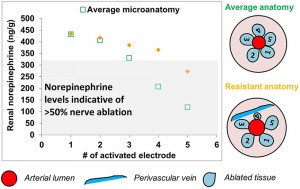 Hypertension editors selected this paper for their 2019 Fall Collection of High Impact Papers.
Hypertension editors selected this paper for their 2019 Fall Collection of High Impact Papers.
Tzafriri AR, Mahfoud F, Keating JH, Spognardi AM, Markham PM, Wong G, Highsmith D, O’Fallon P, Fuimaono K, Edelman ER. Procedural and Anatomical Determinants of Multielectrode Renal Denervation Efficacy.
Summary:
Radiofrequency renal denervation is under investigation for treatment of hypertension with variable success. We developed preclinical models to examine the dependence of ablation biomarkers on renal denervation treatment parameters and anatomic variables. One hundred twenty-nine porcine renal arteries were denervated with an irrigated radiofrequency catheter with multiple helically arrayed electrodes. Nerve effects and ablation geometries at 7 days were characterized histomorphometrically and correlated with associated renal norepinephrine levels. Norepinephrine exhibited a threshold dependence on the percentage of affected nerves across the range of treatment durations (30-60 s) and power set points (6-20 W). For 15 W/30 s treatments, norepinephrine reduction and percentage of affected nerves tracked with number of electrode treatments, confirming additive effects of helically staggered ablations. Threshold effects were only attained when ≥4 electrodes were powered. Histomorphometry and computational modeling both illustrated that radiofrequency treatments directed at large neighboring veins resulted in subaverage ablation areas and, therefore, contributed suboptimally to efficacy. Account for measured nerve distribution patterns and the annular geometry of the artery revealed that, regardless of treatment variables, total ablation area and circumferential coverage were the prime determinants of renal denervation efficacy, with increased efficacy at smaller diameters.

Hypertension. 2019 Sep;74(3):546-554. doi: 10.1161/HYPERTENSIONAHA.119.12918.

